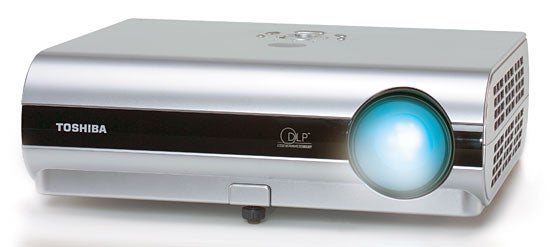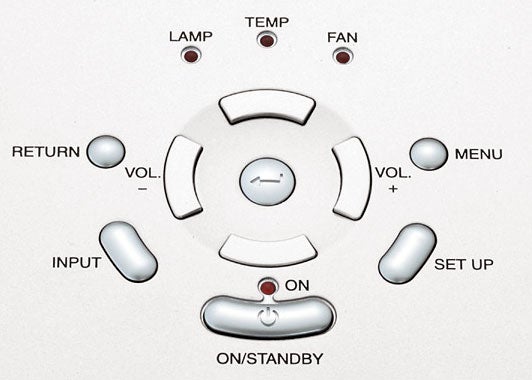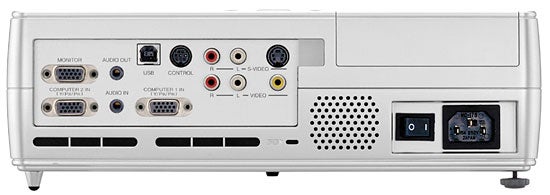Toshiba TDP-SW20 – Wireless DLP Projector Review
Toshiba TDP-SW20 – Wireless DLP Projector
Toshiba thinks that presentations should be sent wirelessly from notebook to projector, but does the reality live up to the ideal?

Verdict
Key Specifications
- Review Price: £866.00
Standing up in front of other people and presenting, whatever the subject matter, can be nerve-wracking. Not many people enjoy the experience, which is of course why software like PowerPoint first came into being – to give presenters a security blanket and audiences something other to look at than the presenter’s rogue nasal hair.
When projectors came along, the job got even easier – no more huddling around a laptop screen. And now wireless projection, which Toshiba touts as one of the TDP-SW20’s main selling points, is supposed to be the next big thing.
In the case of the SW20, the wireless functionality is powered by a PC card, which plugs into a slot at the rear on the right hand side under a plastic flap. The latter, incidentally, isn’t tethered to the machine, so you’ll probably end up losing it.
Install the software on the host laptop and you’ll be projecting without wires in no time at all. It all sounds very straightforward, it works very well, and it’s a boon if you don’t get on with having to sit right next to the projector while you get on with the business of getting your message across.
But it’s not all a bed of roses. Projection via wireless does have its limitations. The main problem is the restricted bandwidth of 802.11b, which limits the data that can be sent across such a connection to 11Mbits/sec. That’s slower than USB 1.1, and it shows.
The first issue is that the display quality isn’t as crisp and clean as it is when the projector’s plugged into your laptop – not a great issue when displaying slides, admittedly. The second is that the screen updates much slower, even when the “High speed” mode is selected, which means that if you were thinking of using it to show video clips, forget it, though you can just about get away with some of the more basic PowerPoint animation effects.
A more prosaic complaint, but a valid one nonetheless, is the positioning of the PC card slot: it’s not recessed far enough for you to replace the cover once the wireless card is installed because it sticks out beyond the edge of the casing. This means that you have to plug it in and take it out every time you pack the projector away and, it may get damaged in the bag if you forget to remove it.
Other than this, the TDP-SW20 is a competent, if pretty run-of-the-mill budget projector. It’s nothing special specification-wise: the resolution is a pretty bog-standard SVGA (800 x 600), and the brightness is nothing to write home about either at 1400 ANSI lumens. The contrast rating of 2000:1 is pretty standard too, these days. There are other projectors on the market with higher resolution and brighter pictures for the same money (£866.10 inc VAT).
The silver and black casing is attractive enough but again it’s nothing out of the ordinary. And while it’s not the bulkiest machine you’ll ever lay eyes on, it’s not the sort of size and weight that’s going to make it pleasant to lug around in a bag with your laptop. It’s roughly the thickness of two reams of A4 paper, and the footprint is slightly narrower and wider than a sheet of the same (285 x 254 x 98mm) and it weighs a hefty 3kg to which you can add the weight of cables, bag and laptop, all of which could quite easily add up to over 5kg in total. Once more, there are projectors on the market for around the same price that are both lighter and more compact.
On the plus side, a rating of 1400 ANSI lumens will cope in all but the brightest of ambient light conditions and for most presentations, 800 x 600 is a perfectly adequate level of detail. The image presented is sharply focussed and the DLP engine, allied with an integrated video scalar processor, means it handles video just as well as it does business presentations.
Also on the plus side is the bulb life of 3000 hours (4000 hours in eco mode), which is on the positive side of generous. Many brighter projectors will need their bulbs replacing earlier, and will ultimately cost you more money. A bulb replacement for the TDP-SW20 will cost around £177 (inc VAT).
A quick look at the rear of the projector reveals a bumper array of connections, although the lack of DVI is somewhat disappointing. Not only do you get a PC card slot for wireless connectivity, but also two D-SUB ports, an S-Video and composite video input too. You also get a computer monitor output plus a pair of 3.5mm audio jacks (input and output).
Again, however, it is not without its problems. The 1400 lumens rating means you’ll have to dim the lights if you want to display at anything near the maximum stated screen size (300in). And we found the display occasionally exhibited an odd shimmering effect in brighter areas of the image.
”’Verdict”’
You’ll be getting the feeling by now that, in pretty much every respect, the TDP-SW20 is outgunned by its competitors in the levels of performance, specification and portability you get for your money.
Don’t get us wrong, we’re not saying that there’s anything major wrong with the TDP-SW20. It’s just that you don’t have to look very hard to find projectors boasting XGA resolution (1024 x 768) with higher brightness ratings for around the same money as this machine (£866.10 inc VAT). And many of them are a good deal more portable too.
Where the TDP-SW20 comes into its own is that it is just about the only projector in its price bracket that comes ready for wireless connection, and it’s this that will ultimately sway buyers one way or the other.
If you think about it hard enough, though, and take into consideration the limitations of wireless projection, you may well come to the same conclusion as we did: that it’s not really worth the sacrifice, even at such a low price.
(table:features)
Trusted Score
Score in detail
-
Image Quality 7
-
Value 7

